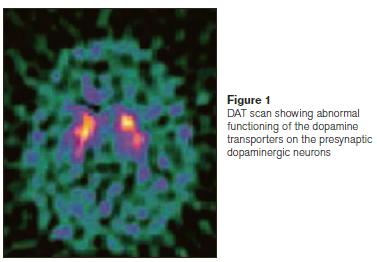A sixty seven year old man presented with rest tremor in both hands for last 6 years with intensification in last 6 months. He is a known case of Bipolar Mood disorder treated with lithium. According to the patient the rest tremor began 2 months after starting lithium therapy for his bipolar mood disorders. The tremor started in his right hand and later the left hand was also involved, increasing in severity and interfering with activities of daily living in the last 6 months. On examination he had asymmetrical (left >right) rest and postural tremor in both of his hands, with rigidity and bradykinesia in both hands (left> right). There was no gaze restriction, autonomic dysfunction or focal neurological deficit. Serum electrolytes including copper studies were normal. Lithium level was in the therapeutic range. MRI scan of the brain was normal.

A diagnosis of DIP was made as his symptoms started shortly after initiation of lithium therapy. However we were reluctant to withdraw the lithium therapy as his mood disorder was well controlled. As it was clinically impossible to distinguish DIP from idiopathic Parkinson’s disease a 123I-ioflupane scan (DAT) scan was performed within a week of his presentation to us (at the 6th year of his symptoms). The scan displayed relatively well demonstrated caudate nuclei bilaterally, apparently normal uptake of activity in the left putamen but reduction in uptake the right putamen/posterior striatum (Benamer et al Scale grade 1).2 There was evidence of abnormal functioning of the dopamine transporters on presynaptic dopaminergic neurons (Figure 1). All those scan findings were suggestive of idiopathic PD rather than DIP. DAT uptake in the striatum is significantly decreased even in early stages of PD ( pre-synaptic dopaminergic receptor deficit) as the motor symptoms of PD do not appear until 60-80% of dopaminergic neurons degenerate. Most drugs have no affinity for the pre-synaptic dopaminergic receptors. DAT scan may show symmetric uptake in the bilateral striatum in patients with pure DIP, even in cases of significant Parkinsonism. However the sensitivity and specificity of DAT in diagnosing DIP needs further evaluation.1
The clinical diagnosis of DIP requires remission of symptoms on withdrawal of the implicated drug. However, in some cases symptoms can persist, progress or reappear after initial disappearance of Parkinsonism.1 Interestingly, Lewy bodies (a pathological hallmark of idiopathic PD but not helpful in clinical diagnosis) have been demonstrated in autopsy of two DIP patients who recovered after stopping the offending drug.3 Lithium, an infrequent cause of Parkinsonism was thought to act by depleting Dopamine stores at the Striatum or by increasing central cholinergic activity.4 We surmise that Lithium (even within therapeutic range) might have unmasked the latent or preclinical stages of Parkinsonism in our patient.1
S Bhattacharjee, R Yela, G Chadwick
St Columcille's Hospital, Loughlinstown, Co Dublin
Email: [email protected]
Acknowledgements
L Wilson, Consultant Nuclear Medicine Physician, Blackrock Clinic, Dublin
References
1. Hae-Won Shin, Sun Ju Chung. Drug-Induced Parkinsonism. J Clin Neurol. 2012; 8: 15–21.
2. Hani T. S. Benamer, Jim Patterson, Donald G. Grosset , et al. Accurate differentiation of parkinsonism and essential tremor using visual assessment of [123I]-FP-CIT SPECT imaging: The [123I]-FP-CIT study group. Movement Disorders.2000;15: 503–510
3. Rajput AH, Rozdilsky B, Hornykiewicz O, Shannak K, Lee T, Seeman P. Reversible drug-induced parkinsonism. Clinicopathologic study of two cases. Arch Neurol. 1982; 39:644–646
4. Holroyd S, Smith D. Disabling parkinsonism due to lithium: a case report. J Geriatr Psychiatry Neurol. 1995;8:118–119